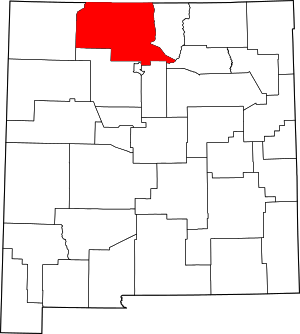Ohkay Owingeh, New Mexico
Ohkay Owingeh (pronounced in Tewa [ʔòhkèː ʔówĩ̂ŋgè], Navajo Kin Łichííʼ) is a census-designated place (CDP) in Rio Arriba County, New Mexico, United States and a federally recognized tribe of Native American Pueblo people. As of 2017 1480 people were estimated to be living in the CDP,[2] with 6,690 in the surrounding Census County Division.[3] The 2010 census found that 1,522 people in the U.S. described themselves as exclusively Ohkay Owingeh[4] and 1,770 as Ohkay Owingeh exclusively or in combination with another group.[5]
Ohkay Owingeh (San Juan Pueblo) | |
San Juan Bautista Church | |
 | |
| Nearest city | Santa Fe, New Mexico |
|---|---|
| Coordinates | 36°3′15″N 106°4′13″W |
| Area | 16.2 acres (6.6 ha) |
| Built | 1540 |
| NRHP reference No. | 74001201[1] |
| NMSRCP No. | 254 |
| Significant dates | |
| Added to NRHP | July 30, 1974 |
| Designated NMSRCP | July 28, 1972 |
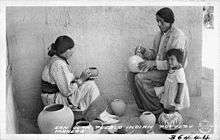
Name
Ohkay Owingeh was previously known as San Juan Pueblo until returning to its pre-Spanish name in November 2005.[6][7] The Tewa name of the pueblo means "place of the strong people".[6][8]
Ohkay Owingeh has the ZIP code 87566 and the U.S. Postal Service prefers that name for addressing mail, but accepts the alternative name San Juan Pueblo.[9]
Geography
Its elevation is 5,663 feet (1,726 m) and it is located at 36°03′12″N 106°04′08″W.[10] One of its boundaries is contiguous with Española, about 25 miles (40 km) north of Santa Fe.
History
The pueblo was founded around 1200 AD during the Pueblo III Era. By tradition, the Tewa people moved here from the north, perhaps from the San Luis Valley of southern Colorado, part of a great migration spanning into the Pueblo IV Era.[6]
Spanish colonial capital
In March 1598, conquistador Oñate traveled from north central México, accompanied by a caravan of Catholic missionaries, a thousand soldiers, colonists, and Tlaxcalan Mexican Indians. The expedition included cattle, sheep, goats, oxen and horses, and arrived at Yungeh —Place of the Mockingbird—in present-day Ohkay Owingeh[11] on July 11, 1598.
The people who met him that day, it is written, were hospitable and offered Yuque Yunque pueblo as guest quarters to Oñate and his party. In royal gesture, he baptized and renamed Caypa pueblo (present-day Ohkay Owingeh) San Juan de los Caballeros, after his patron saint John the Baptist. He then established the first Spanish-Catholic capital of Santa Fe de Nuevo México at Yuque Yunque pueblo.[12] In local history, it is said the event united the two fragmented families of Caypa and Yuque Yunque. Since their arrival from earlier homelands in the northwest, the two pueblos had been divided by the river, split until the expedition party's arrival. When the community offered Yuque Yunque pueblo on the west bank to Oñate, the two fragmented pueblos were made whole again at Caypa.[13] The Spanish capital would be moved in 1610 to La Villa Real de la Santa Fe de San Francisco de Asís.
Popé was a local man who rose to be one of the most regarded leaders of American Indian history. He would play a major role in the Pueblo revolt in 1680. The community was also formally known as the San Juan Indian Reservation.
Present day
Ohkay Owingeh is the headquarters of the Eight Northern Indian Pueblos Council, and the pueblo people are from the Tewa ethnic group of American Indians. It is one of the largest Tewa-speaking pueblos.[14]
The annual Pueblo Feast Day is June 24.[8] For all pueblos, the actual feast day includes a Catholic mass that is held in the morning. Because of historical relations with the Catholic Church, all pueblos have a church located near the center of the village. Most Pueblo people practice aspects of both the Catholic religion and Pueblo belief systems.[15] The tribe owns the Ohkay Casino and the Oke-Oweenge Crafts Cooperative, which showcases redware pottery, weaving, painting, and other artwork from the eight northern pueblos.[14]
Notable natives
- Rose Gonzales, potter
- Evelina Zuni Lucero, writer
- Esther Martinez, linguist and storyteller
- Popé (Po-pay), the Tewa leader of the Pueblo Revolt of 1680[14]
- Rebecca Roanhorse, author
- Alfonso Ortiz, Professor and Cultural Anthropologist
- Leonidas Tapia, potter
- Clarence Cruz, Professor and Traditional Potter
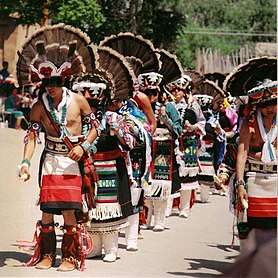
Dancers at Ohkay Owingeh, May 2005 
Buffalo Dance 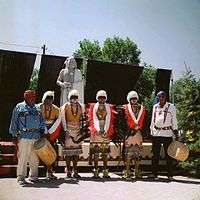
Statue of Popé, Ohkay Owingeh, May 2005 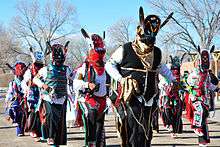
Los Matachines de Ohkay Owingeh, Christmas 2012
See also
References
- "National Register Information System". National Register of Historic Places. National Park Service. July 9, 2010.
- U.S. Census Bureau (2017). "Ohkay Owingeh CDP". United States Census Bureau. Retrieved October 28, 2019.
- U.S. Census Bureau (2017). "Ohkay Owingeh CCD". United States Census Bureau. Retrieved October 28, 2019.
- Census 2010 American Indian and Alaska Native Summary File (AIANSF) - Sample Data, Ohkay Owingeh, New Mexico (San Juan Pueblo) alone (H53)
- Census 2010 American Indian and Alaska Native Summary File (AIANSF) - Sample Data, Ohkay Owingeh, New Mexico (San Juan Pueblo) alone (H53) & (100-299) or (300, A01-Z99) or (400-999)
- Wroth, William H. "Ohkay Owingeh". New Mexico Office of the State Historian. Archived from the original on 2008-05-15. Retrieved 2008-08-10.
- "Pueblo's name predates arrival of Oñate". The Santa Fe New Mexican. 2005-11-15. Archived from the original on February 28, 2006.
- "Ohkay Owingeh (formerly San Juan Pueblo)". Dancing from the Heart. Mother Earth Productions, LLC.
- "87566". Look Up a ZIP Code. U.S. Postal Service. Retrieved December 21, 2011.
- "Ohkay Owingeh". Geographic Names Information System. United States Geological Survey. Retrieved 2009-07-19.
- Matthew J. Martinez. "Remembering 400 Years of Exile".
- "San Juan Pueblo". New Mexico Magazine. Archived from the original on 2009-01-05. Retrieved 2009-07-19.
- Etc., BY L. BRADFORD PRINCE, LL.D. President of the Historical Society of New Mexico: President of the Society for the Preservation of Spanish Antiquities: Vice President of the National Historical Society: Hon. Member of the American Numismatic and Archéological Society: Hon. Member of the Missouri Historical Society; of the Kansas Historical Society; of the Wisconsin Historical Society: Cor. Member of the Texas Historical Society, and Minnesota Historical Society: Trustee of the Church Historical Society, Etc. "San Juan". www.library.arizona.edu. Retrieved 23 April 2018.
- "Ohkay Owingeh Pueblo". New Mexico, Land of Enchantment. New Mexico Tourism Department. Retrieved March 15, 2014.
- "Pueblo Feast Days". Matthew J. Martinez.
External links
| Wikimedia Commons has media related to Ohkay Owingeh, New Mexico. |
- Ohkay Owingeh Dept. of Education
- History of Ohkay Owingeh
- Los Matachines at Ohkay Owingeh, photo gallery
- Ohkay Owingeh, Indian Pueblo Cultural Center
- San Juan Pueblo at National Park Service
- San Juan pottery, photo gallery
